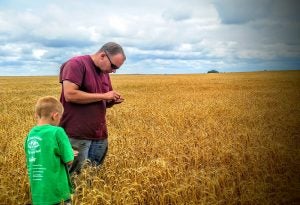The American dream. Many of us who were born and raised here take these words for granted. We don’t realize the things that are sacrificed to come and live, work, and start a new life in the United States — where opportunities are more plentiful than in other areas of the world.
For my husband, that path was the one he chose.
Originally from “the Motherland,” or as most know it, England, he grew up on a hobby farm among other small farms. His parents instilled in him hard work and adventure in life beyond where he grew up. Freshly graduated from Brinsbury Agriculture College and recently back from working on farms in Australia for two years, his father told him of an opportunity to go to America. There was on-the-job training through The Ohio Program. This program brings foreigners into the U.S. to work in horticulture, agriculture, or turfgrass (golf courses). He chose agriculture and got placed on a harvest crew, based in south central Kansas. What better way to experience the Midwest than to work and travel with a harvest crew!
It seems like a simple enough process, right? Not really. Once he was placed with a host farm, he had to start toward a J-1 exchange visa. This visa would allow him to work with in the states while learning U.S. farming and business practices. Basically, he was an intern. This was before the 9/11 attacks. After his first year (and after 9/11), he had to get a different visa, and the process became much more complicated.
His experience in the U.S. affected him every time he went back home to England. He didn’t feel like home was where he fit in — like he was always out of step. There, government regulations were limiting, and as the population of people was rising, farms were being pushed out by housing developments. He felt the pull to uproot everything he considered home, and to start a new one 4,000 miles away in a place where opportunities were more plentiful to build a business from the ground up.
Can you imagine leaving everything you know as home: your family, friends, the land that you were born on? It takes courage to spread your wings to build the life you dream of. Many times he said, “I had to separate my emotional ties to be able to do this.”

Deciding to stay, he weighed the next challenge. He asked me to marry him, but he didn’t want people to think he was marrying me to be able to stay. After many talks with a lawyer, there were two options: apply for green card and spend $4,000 as well as wait up to a year in England until it’s approved, or marry me and spend $2,500 and wait only a few months. We — together — chose for him to marry me and then apply. I became his sponsor, to help him apply for his permanent residency (green card). Marrying a U.S. citizen does not mean you get automatic immigration status; you have to apply with the U.S. Department of Homeland Security to be able to remain. Or to apply for permanent residency you have to apply to the U.S. Citizenship and Immigration Service.
You can apply for a green card through family if you are:
- an immediate relative of a U.S. citizen, this includes spouses, unmarried children under the age of 21, and parents of U.S. citizen petitioners 21 or older
- a family member of a U.S. citizen fitting into a preference category, this includes unmarried sons or daughters over the age of 21
- a family member of a green card holder, this includes spouses and unmarried children of the sponsoring green card holder
- a member of a special category, this can include battered spouse or child, a K nonimmigrant, a person born to a foreign diplomat in the United States, a V nonimmigrant or a widow(er) of a U.S. Citizen
With our immigration lawyer knowing the ins and outs of all the paperwork and new laws, we had piles of papers as thick as your arm to fill out. Most of our money went toward government fees, travel, and paperwork, doctor visits for vaccinations and physicals, and interviews with government officials. This interview was the last “are we going to get it?” The official has to see all the bills that you pay together, accounts in both your names, back taxes that were paid (being a non-citizen you still pay taxes), and pictures of us together at family events. It can get quite personal, but if you have your lawyer there, everything is handled.
Next, you are on a two-year probation as you may call it (conditional green card). You have to stay married to each other during that time. This is a way to make sure that you did not get married under false pretense. Before 90 days of our second anniversary, we had to apply for the 10-year Permanent Resident card. As a green card holder, you pay all taxes as other natural citizens do, get a driver’s license, but you do not get to vote — taxation without representation.
He has resided here, built two businesses here, made a life here with children, new family, and friends. He made new roots in different soil. Our next step for him is his citizenship. As a green card holder, he can apply for naturalization and citizenship. He has to have good moral character, continuous residency, pass English tests, U.S. history tests, and a civics exam, and pay more fees to the government and our lawyer.
As you can see, immigration is not a cut and dry process — it’s a long and confusing process. For those who are willing to go through it, there’s potential to build a life that puts money back into our community and helps build a business that only 2 percent of Americans do.
This is a life he wants, and it’s a life that welcomes those who are willing to work for it. That’s what the American dream is. Work hard, face challenges, make dreams become realities, and give hope to our children that they can do things they put their mind too. The American dream is not dead, just complicated.
Did you like what you read? Sign up here in a heartbeat to get the best from AGDAILY.com!



